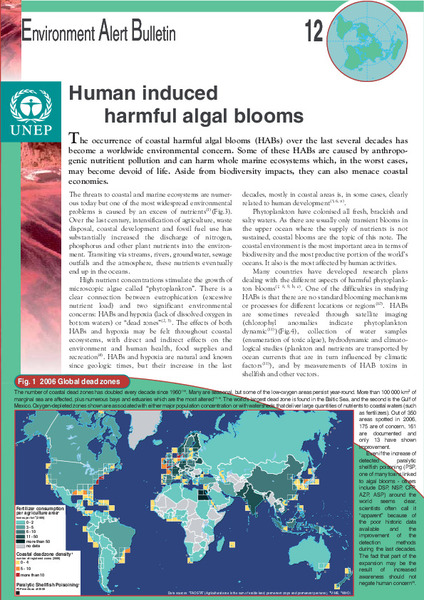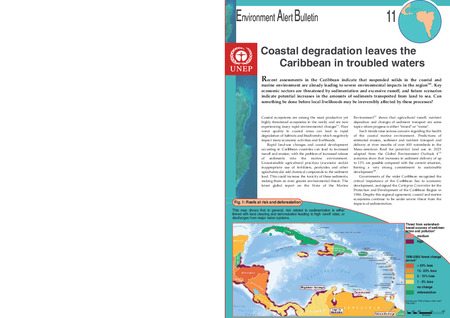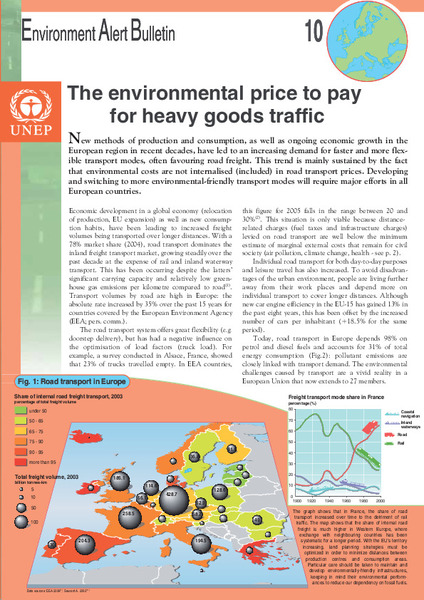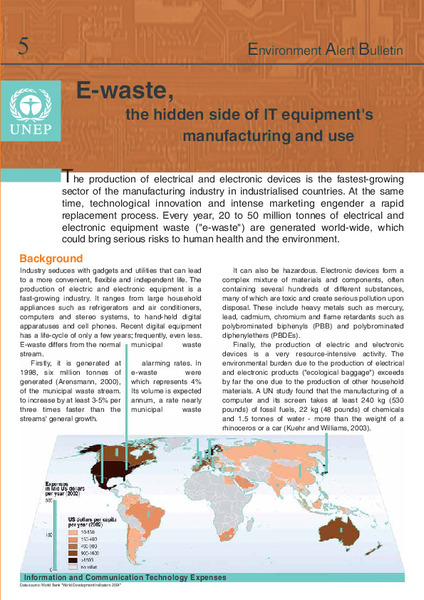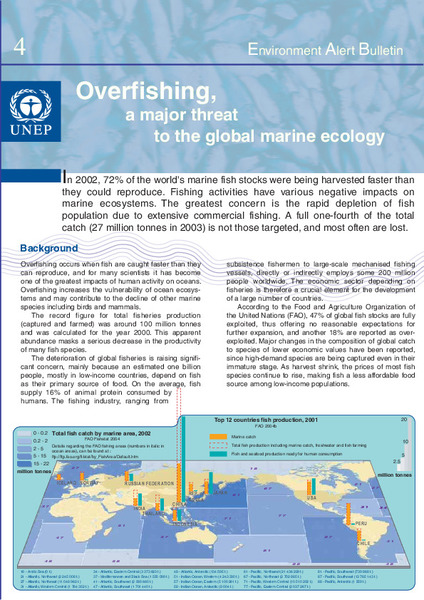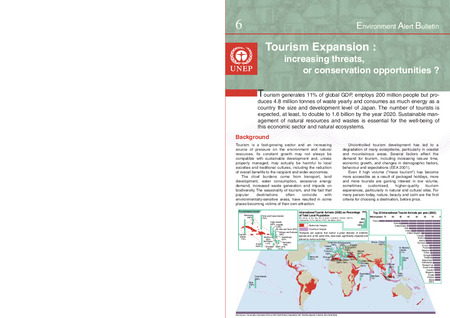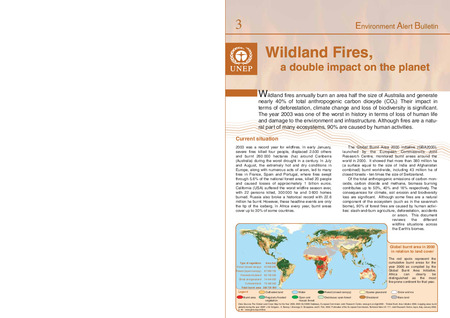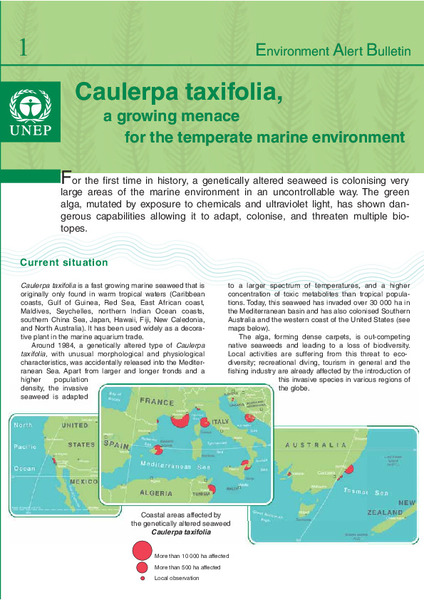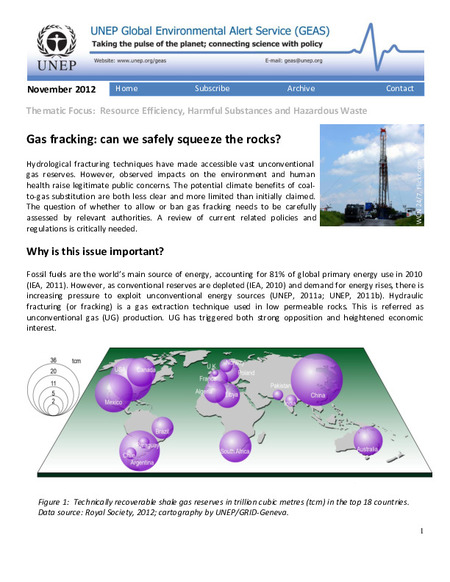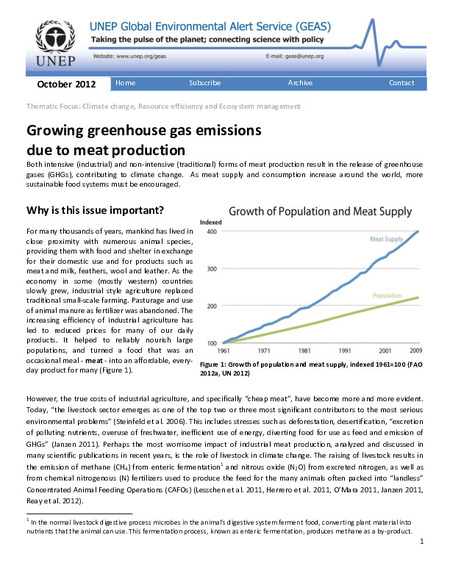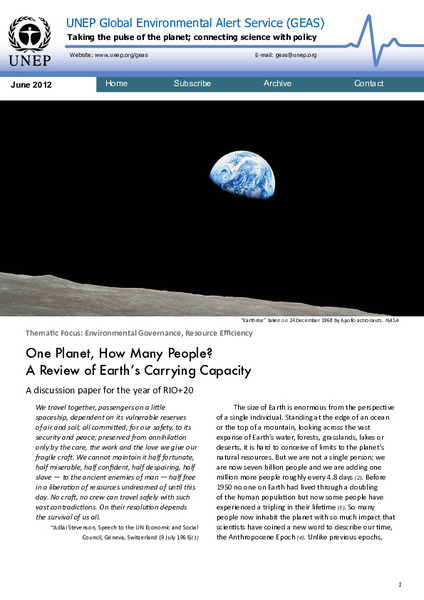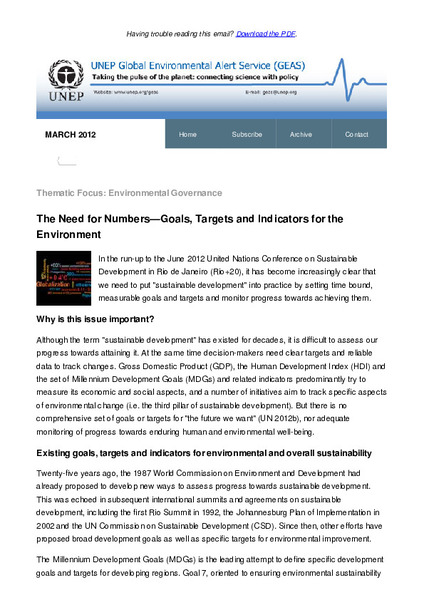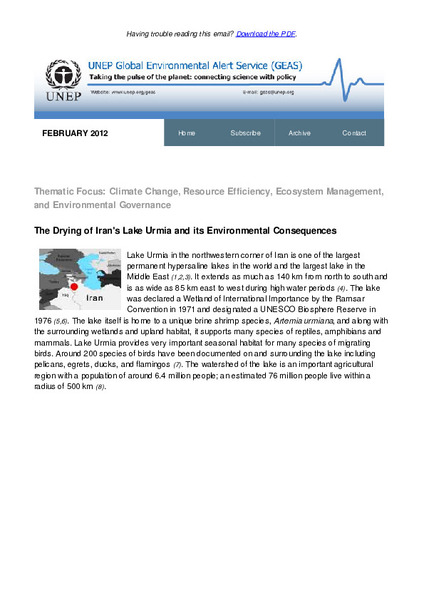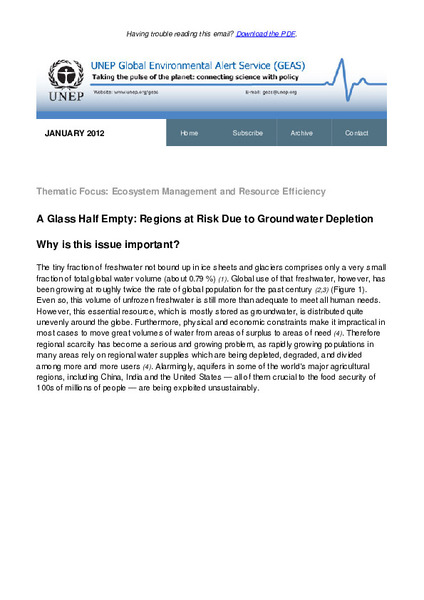Serials: Recent submissions
Now showing items 101-120 of 460
-
Human Induced Harmful Algal Blooms - Environment Alert Bulletin 12
(2008-05)The occurrence of coastal harmful algal blooms (HABs) over the last several decades has become a worldwide environmental concern. Some of these HABs are caused by anthropogenic nutrient pollution and can harm whole marine ... -
Coastal Degradation Leaves the Caribbean in Troubled Waters - Environment Alert Bulletin 11
(2008-02)Recent assessments in the Caribbean indicate that suspended solids in the coastal and marine environment are already leading to severe environmental impacts in the region(a). Key economic sectors are threatened by sedimentation ... -
The Environmental Price to Pay for Heavy Goods Traffic - Environment Alert Bulletin 10
(2007-11)New methods of production and consumption, as well as ongoing economic growth in the European region in recent decades, have led to an increasing demand for faster and more flexible transport modes, often favouring road ... -
Nuclear Waste: Is Everything under Control? - Environment Alert Bulletin 9
(2007-02)50 years after the opening of the world's first civil nuclear power station, very little radioactive waste produced has been permanently disposed of. Moreover, the average age of today’s reactors is approximately 22 years, ... -
Gold Prices on the Rise, Environment under Pressure - Environment Alert Bulletin 8
(2006-11)Although the gold industry is often presented as a “first foreign direct investment” leading to positive outcomes in many developing countries and securing the wealth of many nations, it is also clear that some of its ... -
E-waste, the Hidden side of IT Equipment's Manufacturing and Use - Environment Alert Bulletin 5
(2005-01)The production of electrical and electronic devices is the fastest-growing sector of the manufacturing industry in industrialised countries. At the same time, technological innovation and intense marketing engender a rapid ... -
Overfishing, a Major Threat to the Global Marine Ecology - Environment Alert Bulletin 4
(2004-08)In 2002, 72% of the world's marine fish stocks were being harvested faster than they could reproduce. Fishing activities have various negative impacts on marine ecosystems. The greatest concern is the rapid depletion of ... -
Illegal Oil Discharge in European Seas - Environment Alert Bulletin 7
(2006-02)One-third of global marine oil transportation passes through European waters. Not only oil tankers, but various other cargo ships pose a constant threat of small to medium-scale oil pollution from illegal dumping of oily ... -
Tourism Expansion: Increasing Threats, or Conservation Opportunities? - Environment Alert Bulletin 6
(2005-04)Tourism generates 11% of global GDP, employs 200 million people but produces 4.8 million tones of waste yearly and consumes as much energy as a country the size and development level of Japan. The number of tourists is ... -
Wildland Fires, a Double Impact on the Planet - Environment Alert Bulletin 3
(2004-06)Wildland fires annually burn an area half the size of Australia and generate nearly 40% of total anthropogenic carbon dioxide (CO2). Their impact in terms of deforestation, climate change and loss of biodiversity is ... -
Impacts of Summer 2003 Heat Wave in Europe - Environment Alert Bulletin 2
(2003-03)The extreme drought and heat wave that hit Europe in the summer of 2003 had enormous adverse social, economic and environmental effects, such as the death of thousands of vulnerable elderly people, the destruction of large ... -
Caulerpa Taxifolia, a Growing Menace for the Temperate Marine Environment - Environment Alert Bulletin 1
(2004-01)For the first time in history, a genetically altered seaweed is colonising very large areas of the marine environment in an uncontrollable way. The green alga, mutated by exposure to chemicals and ultraviolet light, has ... -
Loss and Damage: When Adaptation is not Enough - UNEP Global Environmental Alert Service (GEAS) April 2014
(2014-04)The negative consequences of climate change are an increasingly prominent discussion point in global climate change negotiations. This topic has recently risen to global attention with the establishment of the “Warsaw ... -
Gas Fracking: Can We Safely Squeeze the Rocks? - UNEP Global Environmental Alert Service (GEAS) November 2012
(2012-11)Hydrological fracturing techniques have made accessible vast unconventional gas reserves. However, observed impacts on the environment and human health raise legitimate public concerns. The potential climate benefits of ... -
Growing Greenhouse Gas Emissions Due to Meat Production - UNEP Global Environmental Alert Service (GEAS) October 2012
(2012-10)Both intensive (industrial) and non-intensive (traditional) forms of meat production result in the release of greenhouse gases (GHGs), contributing to climate change. As meat supply and consumption increase around the ... -
One Planet, How Many People? A Review of Earth’s Carrying Capacity - A Discussion Paper for the Year of RIO+20 - UNEP Global Environmental Alert Service (GEAS) June 2012
(2012-06)It is estimated that global population reached seven billion in late 2011 or early 2012. As global population has doubled since the 1960s, per capita GDP has grown to more than ten times what it was then. The human impact ... -
Keeping Track of Our Changing Environment--From Rio to Rio+20 (1992-2012) - UNEP Global Environmental Alert Service (GEAS) May 2012
(2012-05)In 1992, the first United Nations Conference on Sustainable Development, popularly known as the Rio Earth Summit, was convened in Rio de Janeiro, Brazil to address the state of the environment and sustainable development. ... -
The Need for Numbers--Goals, Targets and Indicators for the Environment - UNEP Global Environmental Alert Service (GEAS) March 2012
(2012-03)In the run-up to the June 2012 United Nations Conference on Sustainable Development in Rio de Janeiro (Rio+20), it has become increasingly clear that we need to put "sustainable development" into practice by setting time ... -
The Drying of Iran's Lake Urmia and its Environmental Consequences - UNEP Global Environmental Alert Service (GEAS) February 2012
(2012-02)Lake Urmia in the northwestern corner of Iran is one of the largest permanent hypersaline lakes in the world and the largest lake in the Middle East (1,2,3). It extends as much as 140 km from north to south and is as wide ... -
A Glass Half Empty: Regions at Risk Due to Groundwater Depletion - UNEP Global Environmental Alert Service (GEAS) January 2012
(2012-01)The tiny fraction of freshwater not bound up in ice sheets and glaciers comprises only a very small fraction of total global water volume (about 0.79 %) (1). Global use of that freshwater, however, has been growing at ...


